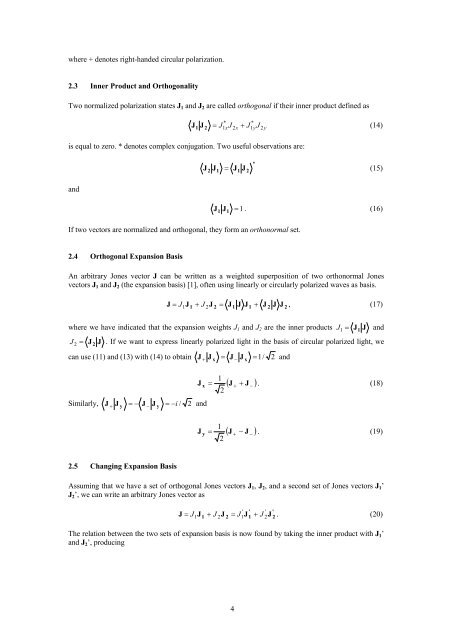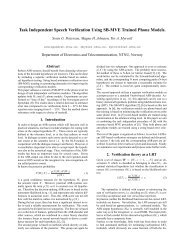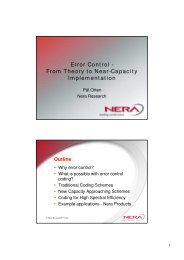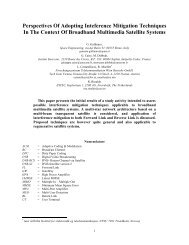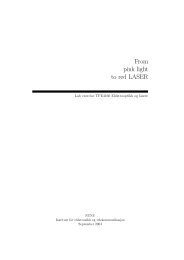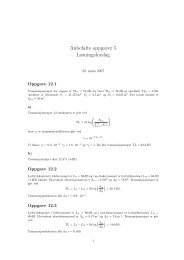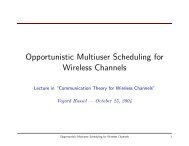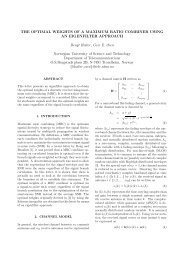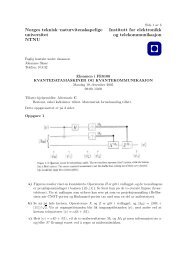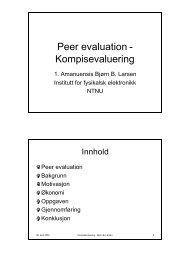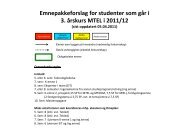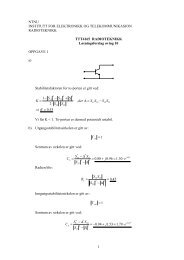Polarization and Polarization Controllers - NTNU
Polarization and Polarization Controllers - NTNU
Polarization and Polarization Controllers - NTNU
You also want an ePaper? Increase the reach of your titles
YUMPU automatically turns print PDFs into web optimized ePapers that Google loves.
where + denotes right-h<strong>and</strong>ed circular polarization.<br />
2.3 Inner Product <strong>and</strong> Orthogonality<br />
Two normalized polarization states J 1 <strong>and</strong> J 2 are called orthogonal if their inner product defined as<br />
* *<br />
J1 xJ<br />
2x<br />
+ J1y<br />
J 2 y<br />
J =<br />
(14)<br />
1 J 2<br />
is equal to zero. * denotes complex conjugation. Two useful observations are:<br />
2 J1<br />
J1<br />
J 2<br />
*<br />
J = (15)<br />
<strong>and</strong><br />
J = 1 . (16)<br />
If two vectors are normalized <strong>and</strong> orthogonal, they form an orthonormal set.<br />
1 J 1<br />
2.4 Orthogonal Expansion Basis<br />
An arbitrary Jones vector J can be written as a weighted superposition of two orthonormal Jones<br />
vectors J 1 <strong>and</strong> J 2 (the expansion basis) [1], often using linearly or circularly polarized waves as basis.<br />
J J + , (17)<br />
= 1J<br />
1 + J 2J<br />
2 = J 1 J J 1 J 2 J J 2<br />
where we have indicated that the expansion weights J 1 <strong>and</strong> J 2 are the inner products<br />
J 2<br />
=<br />
J 2<br />
J<br />
J = J <strong>and</strong><br />
. If we want to express linearly polarized light in the basis of circular polarized light, we<br />
can use (11) <strong>and</strong> (13) with (14) to obtain J J J J =1/ 2 <strong>and</strong><br />
+ x = − x<br />
1<br />
J 1<br />
J x<br />
Similarly, J J − J J = −i / 2 <strong>and</strong><br />
+ y = − y<br />
= 1<br />
2<br />
J<br />
( J + + −<br />
). (18)<br />
1<br />
J y = J<br />
2<br />
( J + − −<br />
). (19)<br />
2.5 Changing Expansion Basis<br />
Assuming that we have a set of orthogonal Jones vectors J 1 , J 2 , <strong>and</strong> a second set of Jones vectors J 1 ’<br />
J 2 ’, we can write an arbitrary Jones vector as<br />
' ' ' '<br />
1J1 + J 2J<br />
2 = J1J1<br />
J 2J<br />
2<br />
J = J +<br />
. (20)<br />
The relation between the two sets of expansion basis is now found by taking the inner product with J 1 ’<br />
<strong>and</strong> J 2 ’, producing<br />
4


